Posts in Category: Pet Tips
THE NAUGHT & NICE LIST: Tips for a Happy & Pet-Safe Holiday
 The holiday season is a feast for the senses — bright lights and candles, mouthwatering treats and shiny, festive decor — which means it’s also filled with potentially hazardous temptations for your furry friends.
The holiday season is a feast for the senses — bright lights and candles, mouthwatering treats and shiny, festive decor — which means it’s also filled with potentially hazardous temptations for your furry friends.
So before you extend the holiday cheer to your animal companions, check out our “Naughty and Nice” list for tips on creating a happy and pet-safe holiday.
Naughty (Keep these out paw’s reach)
- Lilies
- Poinsettias
- Tinsel
- Lit candles
- Shiny, breakable ornaments
- Chocolate
- Grapes/raisins
- Macademia nuts
- Onions
- Fatty meat, stuffing or gravy
- Bread or bread dough
- Snow melt or salt (in case we get any of that white stuff they’re predicting)
Nice (Sure bets for safely sharing the holiday spirit)
- An active toy
- A soft, warm pet bed or blanket
- Lean turkey meat
- Cat- or dog-specific treats (much safer than people food)
- Extra play or snuggle time with you
Holiday Hours
We will be:
- Open from 8-12 pm on 12/24
- Closed on 12/25
- Closed on 12/28
- Open from 8-12 pm on 12/31
- Closed on 1/1
For emergency service during the holidays, contact VSC at Illinois at 312.226.3641.
Wishing you and your animal companions a healthy and happy holiday season!
HAVE A HAPPY AND PET-SAFE THANKSGIVING
 At Thanksgiving we look forward to sharing a feast with our families and friends. But should that celebration include our animal companions?
At Thanksgiving we look forward to sharing a feast with our families and friends. But should that celebration include our animal companions?
Probably not.
A typical Thanksgiving meal contains a number of foods that could put your pet’s health in serious danger.
- Onions, grapes/raisins and chocolate all contains ingredients that are toxic to cats and dogs.
- Rich fatty foods like dark meat turkey or gravy can put your pet at risk for pancreatitis.
- Bread and other yeast-filled items can cause bloat in dogs and should be kept out of paw’s reach.
- And as tempting as it may be to throw Fido a bone, doing so could cause choking or risk internal damage if a sharp piece is swallowed.
- The safest treat is a small amount of lean white meat turkey.
If your pet is nervous around strangers (or if your guests are nervous around pets), consider putting your furry friend in a separate room with a comfy blanket or pet bed. You might even let them tune into the Puppy Bowl.
Once the meal is over, show your pet some love with a long walk or a game of fetch. They’ll enjoy the extra activity and you’ll feel less guilty about the second piece of pie.
Thank you for choosing Medical District Veterinary Clinic at Illinois as your pet’s health and wellness home.
Happy Thanksgiving to all of our furry friends and their humans.
RABIES AWARENESS: PREVENTION IS KEY

According to the Centers for Disease Control and Prevention, more than 55,000 people die each year worldwide due to the rabies virus. Although most of these deaths occur outside of the United States, it is still important to understand the seriousness this disease poses to humans and pets.
September 28 has been declared “World Rabies Day” to help raise awareness about this potentially fatal virus. Dr. Gail Scherba, a veterinary virologist at the University of Illinois College of Veterinary Medicine in Urbana, explains what rabies is and how to keep humans and pets protected.
“Rabies is a zoonotic virus, meaning it can be spread from animals to people. It is most often spread by a bite wound. Once saliva from the infected animal enters the body, the virus begins to invade nerve endings and then spreads to the central nervous system,” says Dr. Scherba. The virus replicates in the central nervous system, and from there will begin to infect the body’s peripheral organs.
The rabies virus targets infection of neurons as well as secretory epithelium (salivary glands). Once the virus has made its way into the salivary gland, the virus can be shed in the saliva and can be transmitted via a bite wound.
According to Dr. Scherba, the incubation period of rabies–the time between exposure to the virus and when the first clinical signs appear–varies depending on species. A typical incubation period for rabies is 10 to 90 days.
Dr. Scherba explains that there are two clinical forms of rabies, “furious” and “dumb.” In the furious form, the animal’s behavior can be altered, and the animal may become aggressive. This form of rabies also causes paralysis of the laryngeal muscles. The afflicted animal is unable to swallow, and often foams at the mouth from excessive salivation.
The dumb form manifests itself as a severe depression and the animal can have a lack of coordination and paralysis. According to Dr. Scherba, both forms of rabies can cause what is called “fatal encephalitis”–inflammation of the brain–in this case due to the virus. The encephalitis causes the animal to have seizures; paralysis will progressively worsen. The animal will eventually go into a coma, which then leads to death.
In the U.S., rabies virus is spread by wild animals, including bats, skunks, foxes, and raccoons. People that are at a higher risk for contracting the rabies virus (veterinarians, researchers, wildlife biologists, people who travel to areas where rabies is prevalent, and so on) should seek prophylactic vaccination.
According to Dr. Scherba, the incidence of rabies in the United States in humans has been declining. In 2012 there was only one confirmed case of a person having rabies in the U.S., which was down from six cases the previous year.
Dr. Scherba emphasizes the importance of having a pet up to date on their rabies vaccine. “If an unvaccinated pet is bitten by a rabid animal, the pet should be euthanized to prevent the spread of rabies,” she says.
If a vaccinated cat or dog is bitten by a rabid animal, the pet would need to be revaccinated for rabies immediately and also be under a strict 45-day observation. Unfortunately, once clinical signs are observed, there is no treatment for animals with rabies; the disease is fatal.
“If a person is bitten by suspected rabid animal, it is important to report the bite to the local health department immediately,” says Dr. Scherba. Regardless of the vaccination status of the animal, the pet should remain under the observation of the owner for 10 days to detect clinical signs of rabies.
A person who is bitten by an animal that is suspected to have rabies should seek medical treatment immediately and may receive the rabies vaccination series. “Rabies is much easier to prevent than it is to treat, so every effort should be made to prevent this fatal virus in humans and pets,” says Dr. Scherba.
For more information about rabies, speak with your local veterinarian.
PLAN CAREFULLY FOR VACATION WITH PET
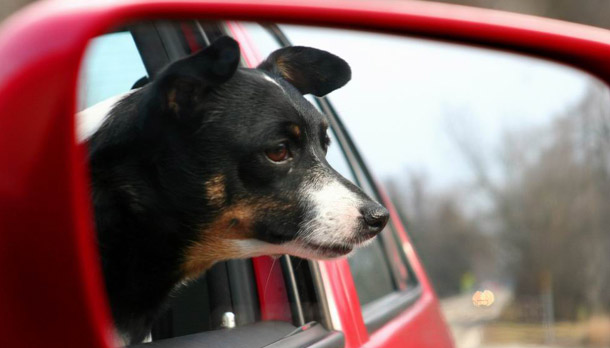
As you arrange the details of your family’s summer vacation, you must also decide what to do with your four-legged friend: To bring, or not to bring? Here’s some advice for pet owners who plan to bring their pets along.
Whether or not to bring your animal on a trip is a decision that should be based on the individual animal. Weigh the benefits against the risks. Staying with a pet sitter or at a kennel might be a better option for animals that are geriatric or very young, need frequent medications, have ongoing medical conditions, or do not adapt well to stressful situations.
If you decide to bring your pet, keep in mind that travel with animals, like travel with small children, requires quite a bit of preparation.
Planning ahead is the most important part of travel with pets. The first consideration will be the mode of travel. Airline travel offers two options: in the cabin, for pets that fit in a small carrier, or in the cargo hold. Airlines have many restrictions on both options, including air temperatures—both minimum and maximum—at which pets cannot fly. Check frequently with your airline to learn about restrictions and fees.
If you will be traveling by car and your pet is not accustomed to long car rides, consider getting your pet used to being in the car by taking several short rides before the trip. It is also very important to restrain animals safely in the car using a carrier or harness combined with a seat belt. Unrestrained animals not only are at increased risk of injury in the event of an accident, but they also can cause car accidents by distracting or interfering with the driver.
Never, ever leave an animal in the car, even for short durations, such as when you stop at a restaurant. Within just a few minutes temperatures can exceed 120°F even with the windows cracked and on days when the outside temperature is moderate.
Animals left at high temperatures are at risk for deadly heat stroke, especially those that are old or young, are brachiocephalic (short-nosed) breeds like pugs and bulldogs, or have heart or lung conditions. Signs of heat stroke include excessive panting and salivation; weakness; collapse; and warm, dry skin. If you suspect your pet is suffering from heat stroke, do not reduce the pet’s temperature suddenly, such as by placing the animal in ice water. Instead, move the pet to a cool area and applying alcohol to the foot pads and cool water to the head. It is important to seek medical care from a veterinarian, because animals suffering from heat stroke can succumb to blood-clotting abnormalities and kidney failure.
When packing for your pet, don’t forget to bring extra food, dishes, leashes, toys, and vaccination records. Always have plenty of water available as well. Be sure to have an adequate supply of medications your pet takes. If an animal has a medical condition, we recommend calling your veterinarian before the trip for suggestions on how to care for your pet during travel. It is also helpful to know where a veterinary clinic is located at your destination.
Lastly, make sure your pet wears identification on its collar with a phone number that reaches you, whether that is your mobile phone or a voice mailbox you can access remotely.
For further information on travel with your pet, contact your local veterinarian.
HEAT STROKE IS DEADLY TO DOGS
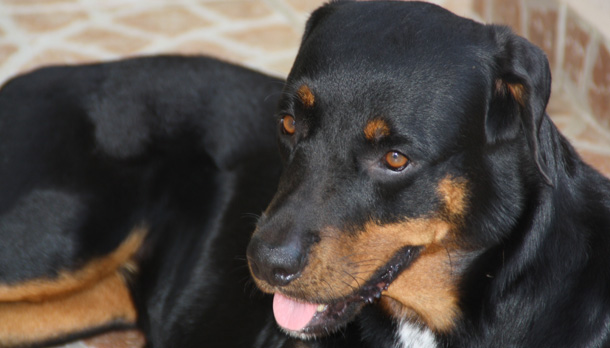
Illinois may be having an unusually cool summer this year, but that does not mean pet owners can dismiss summertime heat risks for pets. Heat stroke is a potentially damaging or deadly risk when an animal overheats, whether from being left in a hot car or from too much sun or exercise.
Our recommendations for keeping animals cool when the weather is warm include not forcing a pet to exercise in the heat and always providing access to shade and plenty of water to drink for animals that are outdoors during the day.
Another important rule: Never leave an animal in a car, even just for a few minutes. The most common cause of heat stroke is leaving a pet in a hot car with little ventilation.
Ten minutes is all it takes for the interior of a car to get up to 100 F, even with the windows cracked, and it can reach up to 130 F in twenty minutes. On hot days, and even on warm days, pets should never be left in a car.
Heat stroke, also known as hyperthermia, occurs when the core body temperature increases and cannot be brought down by the body’s heat-regulating mechanisms. Unlike people, dogs do not control their body temperature by sweating. Instead, they regulate their body temperature by panting.
Signs that can indicate heat stroke include:
- Excessive panting
- Increased salivation
- Weakness
- Depression
- Vomiting
- Diarrhea
- Dizziness
- Animals will often try to cool off if possible (e.g., in a stream)
If heat stroke is suspected, it is important to try to lower the animal’s body temperature and get the pet to a veterinarian, because heat stroke is a serious medical emergency. Owners should try to cool the pet with cool (but not cold) water and wet towels and should allow the animal to drink it is if able.
Veterinarians use cooling water, fans, cool intravenous fluids, gastric protectants, and medications to bring the core body temperature of the pet down safely.
Heat stroke can cause severe damage to an animal’s organs, especially the bone marrow and liver. It can lead to death, even with treatment.
The prognosis of the pet depends on how high the animal’s body temperature reached and the health of the pet before the heat stroke. An otherwise healthy pet before the heat stroke may make a full recovery if its body temperature didn’t drastically increase. If an animal doesn’t receive treatment in a timely manner or if the core body temperature increases too much, heat stroke can lead to organ damage and death of the pet.
Fortunately, preventing heat stroke is easy with common sense. To keep a pet safe in the warm and sunny summer months, never leave the pet in a warm car, provide plenty of water and shade, and do not exercise pets—especially flat-faced pets such as Persian cats, boxers, pugs, etc.—in the heat.
For more information about heat stroke in pets, contact your veterinarian.
CATS’ LOW-STRESS VET VISITS BEGIN AT HOME
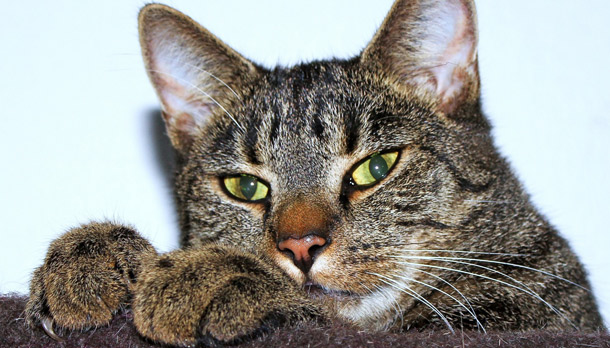
A lot has been said about why to take your cat for regular veterinary visits, but some owners may also need advice on how to get kitty in the carrier, the car, and the clinic without a battle.
Dr. Kelly Ballantyne, a veterinarian with a special interest in animal behavior, practices at the University of Illinois Chicago Center for Veterinary Medicine. She has trained the veterinary staff there to handle every patient in ways that minimize the animal’s stress, but she also understands that, for a lot of cats, anxiety starts at home.
Dr. Ballantyne offers the following recommendations, based on the American Association of Feline Practitioners 2011 Feline Friendly Handling Guidelines, to make your cat’s veterinary experience as pleasant as possible.
Lesson 1: Carrier = Good
Teach your cat to associate the carrier with good things so she will go into the carrier voluntarily. Leave the carrier out in a room that your cat frequents at all times. Place a soft blanket or bed inside the carrier to encourage her to use it as a resting area. If she investigates the carrier, toss in a favorite treat or toy.
Lesson 2: Take Your Time
On the day of your appointment, locate your cat well before you need to leave the house and encourage her to enter the carrier on her own.
Lesson 3: Bring Blankie
To increase your cat’s comfort while traveling in the car and while at the clinic, bring items that carry a familiar scent for her, such as a favorite bed, blanket, or toy.
Lesson 4: Schedule for Quiet Times
If your cat has become very upset during veterinary appointments in the past, mention this when scheduling your appointment so the veterinary staff can prepare for her arrival. They may be able to schedule you at a time of day when there will be fewer appointments, allowing your cat to be placed in an exam room and seen right away to minimize stress.
Lesson 5: Be a Role Model
Your emotions can affect your cat’s emotions. Try to remain calm and positive during your appointment.
Lesson 6: Practice, practice, practice
Rehearse veterinary examinations at home and pair the handling with positive rewards such as petting, praise, or treats. You can practice handling the paws, looking in the ears, opening the mouth, and feeling over the legs and body, unless you are concerned that your cat may become aggressive with this type of handling at home.
Lesson 7: Post-visit Re-entry Plan
Because you cat brings home the scents of the veterinary clinic when she returns home, the cats that stayed home may not recognize her and may attack. Leave your cat in the carrier for a few minutes to see how all of your cats react to her.
If you have experienced this problem before, put your cat in a safe quiet room with food, water, and a litter box for at least 24 hours. Feed your cats or play with them on either side of the door and wait until they appear consistently calm on either side of the door before letting them together.
If you would like additional advice about calming your kitty, please contact your veterinarian or make an appointment for a behavioral consultation with Dr. Ballantyne.

Dr. Kelly Ballantyne
Veterinarian
LOWERING THE ‘BOOM’: REDUCING PETS’ NOISE SENSITIVITIES
When summer thunderstorms roll in, some pets dive for cover. If your dog or cat is among those terrified by storms or other sudden, loud noises, such as fireworks, there are steps you can take to help reduce your pet’s anxiety.
According to Dr. Kelly Ballantyne, a veterinarian with a special interest in animal behavior, the reason pets are scared of thunderstorms isn’t always clear. One study found that a traumatic experience linked to noise was the likely origin of noise sensitivity in only about a third of pets with these phobias. Other factors that may contribute to noise sensitivities include chronic stress, genetics, neurochemical imbalances, and a change in hearing.
Practicing at the University of Illinois Chicago Center for Veterinary Medicine, Dr. Ballantyne offers behavior consultations to help pets with phobias and other behavioral issues.
She says it is perfectly normal for a pet to be scared by the loud noises and flashes the first time the pet experiences a thunderstorm or fireworks. A pet may react defensively to these high-decibel noises because they probably hurt the pet’s ears, they lack a regular pattern, and it’s difficult to figure out where they are coming from.
It isn’t normal, however, if the animal does not get used to storms, and each thunderstorm is as terrifying as the previous one. Unfortunately, thunderstorms are common, and these frequent stressors can reduce a pet’s quality of life. Addressing your pet’s fears is important for the sake of the pet—not to mention the household objects sometimes destroyed by frightened pets.
Dr. Ballantyne suggests several measures that may help noise-sensitive pets feel a little safer and less frightened during a thunderstorm.
“First, try to make a safe place where your pet can go,” she says. “An interior room with no windows is ideal because it is more sheltered from noise and the flashes of light. Avoid crating your pet unless the pet already feels that the crate is a safe place.”
When pets are already hiding, don’t force them out: that can scare and stress them more. Playing music or increasing the white noise in the house can decrease the perceived amount of noise from the storm.
Your behavior around your pet also plays an important role in managing the pet’s anxiety during a storm. You should avoid either comforting or punishing the pet, and you should stay calm to avoid increasing the pet’s anxiety.
If your dog isn’t too scared, you can try to play with him. Interactive toys, such as a Kong filled with food, can help as well if he is willing to eat.
A pheromone spray for dogs called DAP helps reduce anxiety in some dogs. It can be sprayed on a bandana and tied around the pet’s neck during a storm.
Dr. Ballantyne acknowledges that noise sensitivities can be hard for owners to manage. Sometimes you can do everything right and your pet is still scared of the storms.
“Don’t hesitate to ask your veterinarian for help,” advises Dr. Ballantyne. “If nothing else is working, your veterinarian can prescribe anti-anxiety medication to augment the behavior modification plan.”
Don’t forget that a pet that is scared of thunderstorms will likely have a similar reaction to fireworks. These pets should be given a safe place to hide during the celebration and should never be taken to watch fireworks.
If you have questions about pets’ noise sensitivities, please contact your veterinarian or a veterinary behaviorist.

Dr. Kelly Ballantyne
Veterinarian
IS YOUR PET READY FOR HEARTWORM SEASON?
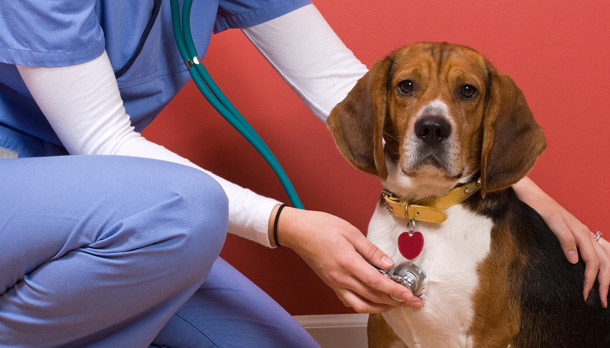
Thanks to an extremely harsh winter, we may see a decrease in the mosquito population compared to previous years. Still, we must take precautions against heartworm disease. Mosquitoes are the intermediate host of heartworms and are responsible for spreading this deadly disease. Dogs cannot give the disease to other dogs without the aid of mosquitoes. As pet owners, we need to be responsible for protecting our pet’s health by preventing heartworm disease.
Heartworm disease is caused by Dirofilaria immitus. When this parasite is mature, it resides in an animal’s blood vessels very close to the heart, resulting in heart disease and elevated blood pressure. Currently there is only one FDA approved medication that kills the adult worms in dogs, and nothing is available to kill adult heartworms in cats. This is why preventing adult worms is so important.
How does heartworm prevention work?
There are many preventatives on the market: oral, topical and injectable forms. Most preventatives need to be dosed every 30 days. When an animal receives a monthly dose of prevention, the preventative kills any microfilaria (baby heartworms) that an animal may have been exposed to within the last 30 days. That is why dosing every 30 days is so important. Even though transmission of heartworms in the Chicago area during the winter months is unlikely we still recommend year around prevention. Most heartworm preventatives also protect pets from intestinal parasites, which are diagnosed year around and can be passed to humans.
Here at our clinic we recommend Sentinel & Revolution as our primary heartworm preventatives. Sentinel is a dog product that is given orally every 30 days. It prevents heartworms, intestinal parasites (roundworms, hookworms, whipworms), and flea infestations. It is one of the most broad-spectrum preventatives on the market and that is why we currently recommend it over the very popular Heartgard. Revolution is both a canine and feline product. It is topically applied every 30 days. It too is a broad-spectrum preventative. We strongly recommend this for cats, and it is also available for dogs. Ask your veterinarian which option would be best for your pet.
Drew Sullivan, DVM
Veterinarian
PAWS OFF THESE POTENTIAL PET POISONS
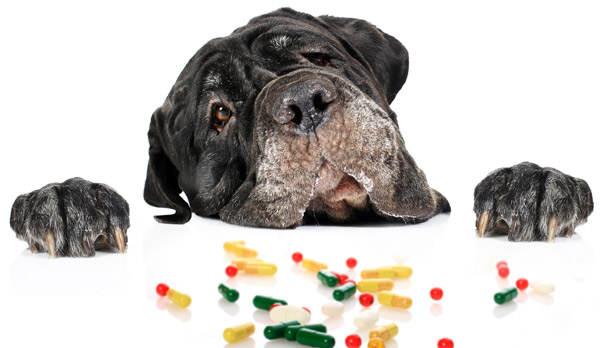
I’ve been talking to a lot of clients about the common household items that can be toxic to their pets. According to 2012 data from the Animal Poison Control Center, based in Urbana, Ill., prescription human medication was at the top of the list for the fifth year in a row. The most common meds ingested by dogs and cats include heart medications, antidepressants, and pain medications.
The comprehensive list from the ASPCA website follows:
- Prescription Human Medications – most commonly heart medications, pain medications & antidepressants
- Insecticides – most commonly occurs when cats receive flea/tick preventions & shampoos made specifically for dog use
- Over-the-Counter Human Medications – most commonly over the counter pain medications (naproxen, ibuprofen, and aspirin)
Veterinary Products and Medications - Household Products – soaps, cleaners, batteries, mothballs, glue, antifreeze
- People Food – coffee grounds, xylitol (artificial sweetener often found in gum), grapes, raisins
Chocolate - Plants- Lilies, Marijuana, Sago palm, Tulip, Azalea, Oleander, Castor bean, Cyclamen, Kalanchoe, Yew, Amaryllis, Autumn crocus, Chrysanthemum, English ivy, Peace lily, Pothos, Scheffler
- Rodenticides – most commonly mouse/rat poisons
- Lawn and Garden Products
To help prevent accidental poisonings, keep medicines, household cleaners, pesticides and automotive products stored and out of paw’s reach. Never give any medications or supplements to your pet without first consulting your veterinarian. And always read the label of flea/tick products before applying to your pet. If a product is labeled for dog use only, it can cause serious and often life-threatening side effects in cats.
If you think your pet has ingested a poisonous substance, call your veterinarian or the ASPCA Poison Control Center (1-888-426-4435.) Before you call, make sure you have the following information accessible: name, address, phone, details about exposure, product container, species, breed, age, sex, weight, and be able to describe symptoms your pet is experiencing.
Drew Sullivan, DVM
Veterinarian


